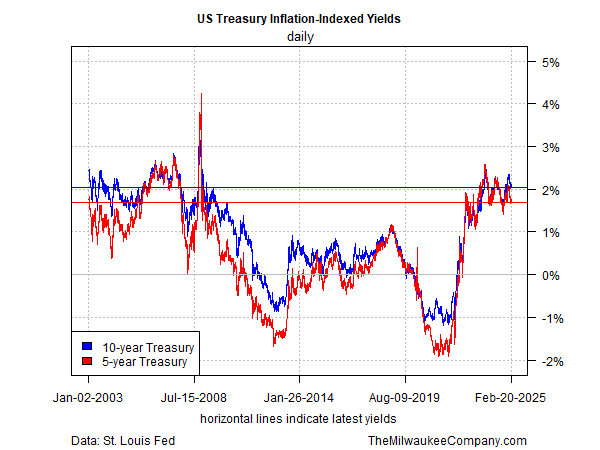SoFi shares rise as record revenue, member growth drive strong Q3 results
At a time of increased uncertainty about inflation, the relatively elevated real yields available in inflation-indexed Treasuries offer a partial antidote of certainty for anxious investors.
Using the 5-year and 10-year yields for Treasury Inflation-Protected Securities (TIPS) as proxies, the market is providing real payout rates near the highest level in 16 years. Is it an offer too good to pass up? The answer depends on your expectations and goals.
As a starting point for deciding if it’s timely to lock in current real yields, let’s start with a simple fact: the market is still pricing in a relatively compelling bargain.
Although real yields are below recent highs, the current rates are sharply above levels that prevailed over much of the past 15 years.

The 10-year real yield is currently 2.05% (Feb. 21), moderately higher than the 5-year’s 1.68%, according to Treasury.gov. If you buy and hold TIPS at current rates, you’ll lock in the yields through the maturity dates. For instance, buying and holding the 10-year TIPS ensures that you’ll earn a 2.05% real yield for the next decade.
The first step in thinking about whether current real yields are compelling, or not, is comparing the rates with what’s offered through nominal yields. Standard Treasuries for 5- and 10-year maturities are currently yielding 4.34% and 4.50%. The key question: Is it timely to lock in a higher nominal or real yield?
The answer, of course, is that no one knows. Because yields and inflation will fluctuate, and no one really knows in what direction or magnitude, there’s an element of uncertainty that can’t be modeled away. But as we think through assumptions about what could happen, we can decide which set of yields looks more compelling. Let’s use the 10-year maturities as an example.
If you buy and hold a standard 10-year Note you’ll earn 4.50% — that’s 2.45 percentage points above what a real 10-year Note offers. Is the higher conventional yield a better deal? A key factor for deciding is your outlook for inflation.
Consider that if inflation is 2.45% over the next 10 years, the nominal and real 10-year Treasuries will generate identical results. (I’m fudging the ex-ante math re: performance expectations a bit here for simplicity to make a point.) Note that the yield spread for the current 10-year yield less its inflation-indexed counterpart is also 2.45%, which can be thought of as the market’s implied inflation forecast.
The question is whether your inflation forecast is higher, lower or equal to the market’s outlook. The answer will play a role in weighing the pros and cons of the current real vs. nominal yield.
Another way to think about TIPS vs. standard Treasuries is that each one locks in one form of yield while letting another vary through time. When you buy a nominal Treasury, you’re locking in the nominal yield and allowing the real yield to float. By contrast, when you buy a TIPS you’re locking in a real yield, which allows the nominal yield to vary through time. In other words, standard and inflation-indexed Treasury yields are more or less pure hedges for their counterpart from a yield perspective.
This introduces another dimension that can (and should) influence your decision, namely: What’s your view on the future path of nominal and real yields? For example, buying and holding TIPS today will generate a guaranteed real yield through maturity. Meanwhile, the same investment will generate a changing nominal yield – changes that could be dramatically different vs. current yields. That introduces behavioral risk in the sense that even though you’re comfortable locking in today’s real yield, you may be disappointed with the future nominal yield that the TIPS investment generates.
The main takeaway: real yields, even when relatively elevated, aren’t a free lunch. Rather, these securities offer a way to hedge a particular liability: future inflation. The wisdom of today’s decision can be satisfying, or not, depending on where inflation goes from here. Because the future is always uncertain, however, the best we can do is make assumptions about what could happen to guide us today.
On that note, the analysis starts from a simple observation: real yields are relatively high vs. the past decade and a half. That’s one reason to consider locking in current real yields, but it’s only a first step in a multi-process review for deciding what’s right for you.
